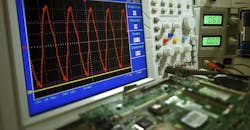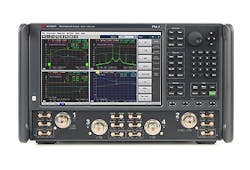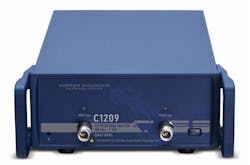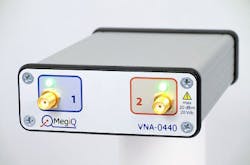Vector network analyzers (VNAs) have long been symbolic of the RF/microwave industry—the one instrument that is only used in the high-frequency industry, and only by those with exceptionally high test-and-measurement budgets. But that has changed in recent years, with more and more engineers finding value in VNA measurements, and more users finding VNAs that are affordable while also providing the performance they need. The ready availability of low-cost VNAs, many operating in the microwave frequency range, begs the question: Why bother with a more expensive model?
As with any test instrument, having a top-of-the-line VNA ensures the fewest limits on performance and measurement capability, along with the peace of mind in knowing that no compromises were made in developing the instrument. High-performance benchtop VNAs from leading instrument suppliers such as Anritsu Co., Keysight Technologies, and Rohde & Schwarz are available with frequency coverage well into the millimeter-wave range. All boast unparalleled accuracy when properly calibrated and set up—e.g., with phase-stable cables and properly torqued coaxial connectors attaching a device under test (DUT) to the VNA.
At one time, specifying a microwave VNA automatically meant a six-figure price tag, because of the extensive electrical and mechanical engineering required to design and produce a reliable instrument with repeatable performance. A VNA is a complete measurement system—with test signal sources, receivers, high-speed switches and low-loss transmission lines—all under the control of a high-end embedded computer. Signals are switched between the ports of a DUT to measure direct and reflected power levels in forward and reverse directions, the better to understand the effects of a DUT’s impedance on the rest of a system.
Even when comparing different benchtop instruments, lower cost need not mean a drastic drop in performance. The most obvious sacrifice when seeking lower VNA cost is in frequency range. Most benchtop VNA manufacturers offer their products as a series of instruments, with a single low frequency limit and an increasing number of upper-frequency limits as the price increases.
For example, the N523xB PNA-L Series from Keysight is an economy version of the company’s higher-performance N524xB PNA-X and N522xB PNA VNA lines, which offer higher upper-frequency limits (67 GHz vs. 50 GHz), although all three series of instruments offer top frequencies that increase with price (Fig. 1). This allows a specifier to select a VNA based on frequency requirements rather than just picking the widest-bandwidth model (at the highest price in the series).
Within each instrument manufacturer’s series of benchtop VNAs, the highest-priced VNAs bring the highest performance, often with advanced features such as nonlinear and pulsed measurements, and even spectrum analyzer measurement capabilities. But the drop-off in performance for an economy model is often not that significant. When comparing the top of the line to economy models, some key parameters (e.g., accuracy and measurement resolution) will certainly fade with falling price. However, for many applications, the lower performance levels of economy benchtop units may be good enough.
Typical VNA performance differences are in such parameters as trace noise, source power, and dynamic range, where the lower levels of performance may be adequate for some measurements. While the most demanding R&D applications may require the best measurement performance possible, less bandwidth and economy-grade performance may be adequate for production testing, provided that measurement repeatability is sufficient. In considering the needs of the application, a considerable cost savings is possible even when searching only among benchtop VNAs.
Modular Flexibility
By separating the computer and display screen from the RF/microwave measurement hardware, a new generation of modular VNAs has been created, allowing operators to control the VNA and display results with software on an external computer. The approach provides flexibility in upgrading test and operating-system (OS) software at a fraction of the cost of a benchtop VNA. But how does the large difference in cost relate to performance of each type of VNA?
Currently available USB-based VNAs offer a wide range of price and performance levels, so that specifiers can save on cost by matching performance levels to application needs. The drop-off in performance between benchtop and USB VNAs might be the least when considering an instrument such as the C1209 two-port VNA from Copper Mountain Technologies. For a frequency range of 100 kHz to 9 GHz, it offers a dynamic range (145 dB) to match the best benchtop VNAs, achieved in conjunction with a source power range of −60 to +15 dBm.
The C1209 is physically larger than many of the company’s other USB VNAs, in a half-rack configuration (Fig. 2) measuring 377 × 210 × 95 mm, although a fraction of the size of a typical benchtop VNA. It also provides a generous amount of measurement points (500,001) for a USB VNA, and measurements speed of 15 μs to meet the needs of production testing. It performs all four S-parameters and is controlled by a PC with the company’s downloadable software.
Smaller, less expensive, and less capable, but perhaps providing performance sufficient for some applications, the VNA-0440 two-port USB VNA from MegiQ also performs all four S-parameter measurements from 0.4 to 4.0 GHz (Fig. 3). It provides less test points (20,001) and dynamic range (95 dB) but offers wide test port power range of −30 to +5 dBm with ±1 dB accuracy.
A number of manufacturers offer lower-cost USB-based VNAs, including Anritsu, Copper Mountain Technologies, Pico Technology (which is sold by Saelig), MegiQ, and TAPR with a low-frequency (200 kHz to 100 MHz) unit. Long-time instrument maker Tektronix recently joined the fray with its own line of 3- and 6-GHz USB VNAs, at only $12,000 USD for the 6-GHz version. In addition, National Instruments has developed a lower-cost, high-performance VNA in PXI format (for use in a PXI chassis).
These are examples to demonstrate the differences in performance between higher-costing benchtop instruments and more economical USB-based VNAs. Instruments are available in both configurations with two or four ports and various levels of performance, although with typically higher accuracy and faster measurement speeds provided by the larger desktop instruments. When performance is essential, the choice will undoubtedly be a benchtop VNA. But for general-purpose VNA measurements, especially where cost is a concern, starting the selection process from the growing choice of commercial USB VNAs can provide significant savings without significant sacrifice in performance.
About the Author
Jack Browne
Technical Contributor
Jack Browne, Technical Contributor, has worked in technical publishing for over 30 years. He managed the content and production of three technical journals while at the American Institute of Physics, including Medical Physics and the Journal of Vacuum Science & Technology. He has been a Publisher and Editor for Penton Media, started the firm’s Wireless Symposium & Exhibition trade show in 1993, and currently serves as Technical Contributor for that company's Microwaves & RF magazine. Browne, who holds a BS in Mathematics from City College of New York and BA degrees in English and Philosophy from Fordham University, is a member of the IEEE.




